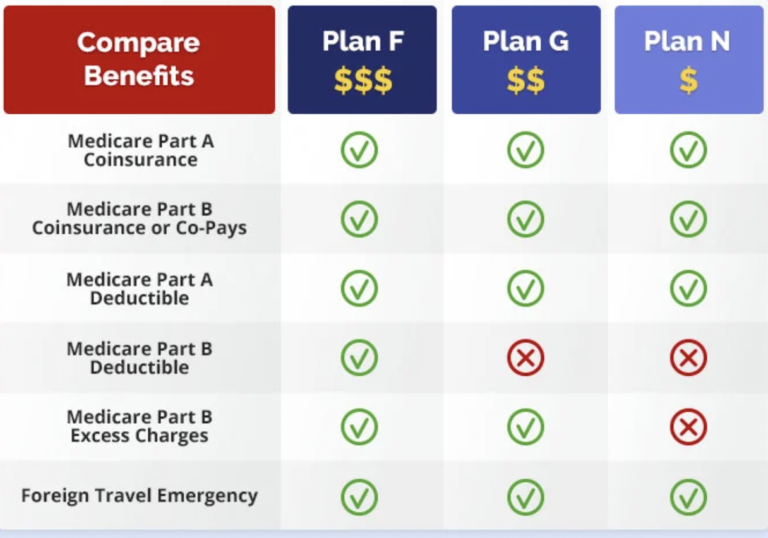When it comes to retirement we’re faced with a number of high impact financial decisions in a relatively short period of time. One of those decisions is choosing your Medicare coverage. For those approaching eligibility for Medicare, it can be fairly daunting to navigate Medicare’s enrollment process, and coverage options. In order to shed some much needed light on the Medicare system, the following is a comprehensive guide to help you get enrolled in the appropriate coverage based on your unique circumstances.
Medicare was started in 1965 to provide aging Americans with standardized and affordable healthcare. Starting at age 65 all Americans are eligible to enroll in Medicare, which is administered through the Federal government. For most Americans, enrolling in Medicare means forgoing/stopping existing coverage through a private insurer or employer, and instead electing to take the Federal government’s coverage through Medicare.
Medicare breaks up its coverage into several different parts. Parts A & B are separate policies that together serve as the core coverage for enrollees. Parts A & B are considered the core or “traditional” Medicare policies because they have the widest scope of coverage, and tend to cover what we think of as traditional medical care. These policies are standardized in the fact that everyone insured under Parts A & B has the same coverage.
Medicare Part A - Hospital Insurance
Medicare Part A is the portion of Medicare that covers costs associated with in-patient hospital care. For individuals that are eligible for Social Security benefits, or have a spouse eligible for benefits, there is no monthly premium for Part A. If you’re on Medicare, and admitted into a hospital, it’s your Medicare Part A coverage that will be applied. Medicare Part A will cover semi-private rooms, general nursing care, meals, drugs that are administered, and supplies used during your care. However, that doesn’t mean your in-patient services come with no out-of-pocket cost. The deductible for Part A in 2024 is $1,632. Meaning, you will pay for the first $1,632 worth of inpatient care you receive. All costs beyond that will be covered by your Part A coverage for the first 60 days spent in the hospital.
For extended hospital stays that last 60 – 90 days there is an out-of-pocket cost of $408 per day in 2024. This additional cost would start on day 61 of your hospital stay, and last until day 90. From day 91 and beyond the cost doubles to $816 per day. Your $1,632 deductible, and the 60 / 90 day thresholds are triggered based on what is known as a benefit period. Your benefit period starts the day you are admitted into a hospital, and ends when you have been out of the hospital for 60 continuous days.
Overall, Medicare Part A makes short stints of in-patient care relatively affordable for many Americans. However, costs can add up quickly if you have multiple benefit periods in a single year. Your $1,632 deductible resets each benefit period, so in theory you could have several different benefit periods, and owe several Part A deductibles in a single year across you and/or a spouse. Stay tuned for ways of limiting your out-of-pocket risk through supplemental coverage.

Medicare Part B - Medical Insurance
Medicare Part B is the portion of Medicare that covers outpatient medical care. This includes both preventive care, and medically necessary services. The monthly premium for Part B in 2024 is $174.70. Coverage for things like wellness visits, screenings, lab tests, and many other outpatient services fall under Part B. The full list of covered services can be found here. In addition to monthly premiums there is also a fairly low annual deductible of $240, which must come out-of-pocket before Part B coverage kicks in. Once Part B coverage is triggered 80% of your covered care is paid for by Part B. You will foot the bill for the remaining 20%. As discussed, it’s important to note that there is no out-of-pocket limit on your Part A & B coverage. For many people that can be unsettling, which is why certain supplemental plans offer a limit on out-of-pocket costs.
Enrollment in Part A & B
In order to discourage adverse selection, the Federal government wants Americans to enroll in Parts A & B as soon as they turn 65. In fact, there is a late enrollment penalty for individuals who do not enroll in Parts A & B during their initial enrollment period. Failure to enroll during your initial enrollment period will trigger an increase in Part B premiums for the remainder of your Medicare coverage! (There is an exception for individuals age 65+ who are still covered through an employer’s plan)
The Initial Enrollment Period (IEP) for Medicare is a 7 month window starting 3 months prior to the month of your 65th birthday, and lasts for 3 months after. The enrollment process for A & B depends on whether you are currently receiving Social Security benefits.
For individuals who are receiving Social Security payments at least 4 months prior to their 65th birthday, the Social Security Agency will automatically enroll you in Medicare Parts A & B. That means there is no action required on your behalf to get enrolled. You will receive your Medicare coverage card approximately 3 months before you turn age 65, and your A & B coverage will begin on the first day of your birthday month. Your $174.70 premium for Part B will be taken directly from your monthly Social Security check.
For individuals who are not currently receiving Social Security payments, action must be taken to get enrolled in Medicare during your initial enrollment period. Enrolling in Parts A & B can be done by visiting your local social security office, calling the Social Security Agency, or enrolling online. The online enrollment application can be found here. Once enrolled, you will have to pay your premiums either online or through the mail, typically on a quarterly basis.
Medicare Part D - Prescription Drug Coverage
With inpatient and outpatient services covered under Parts A & B, that leaves prescription drug coverage. Medicare Part D is the portion of Medicare that provides coverage of prescription drugs. Action must be taken to enroll in Part D during your Initial Enrollment Period, whether you are receiving social security or not. While enrollment in Part D is technically optional, there is a late enrollment penalty that will forcibly increase your Part D premiums for the remainder of your coverage if you choose to delay enrollment. In most cases, immediate enrollment in Part D is the optimal choice.
While Part D is regulated by Medicare (cost and coverage must meet certain standards), coverage is actually bought and administered through private insurers. This is where Medicare coverage becomes a bit less standardized. With Part D administered through private insurers, plans can vary in pricing and coverage to a degree. Now instead of everyone having the same exact coverage as they do under Parts A & B, individuals can essentially shop around for the best coverage at the lowest prices. The Centers for Medicare & Medicaid Services projects that the average monthly premium for Part D coverage in 2024 is $55.50, and plans are not allowed to exceed a $545 annual deductible. Once your annual deductible is met there are copays (flat dollar amounts) or coinsurance (percentage of cost) that may need to be paid out-of-pocket each time you fill a prescription.

Selecting Your Part D Coverage
When it comes to selecting your Part D coverage you will want to take into account any prescription drugs you are currently taking. Part D providers break out their drug coverage into different tiers. This is known as a formulary. Drugs that are in lower tiers (tier 1-2) come at the lowest out-of-pocket cost to you, and are typically generic drugs. Medicare provides a helpful comparison tool that allows you to input your prescriptions, and shop the coverage available in your area. It’s also worth inputting a preferred pharmacy to determine whether your pharmacy falls into the plan’s preferred network. This can help reduce your prescription cost.
One item to note around Part D is that coverage can change year-to-year. Drugs can move up and down tiers, or gain and lose coverage. Premiums and deductibles can change annually, so it’s not a bad idea to shop your coverage around each year to see what alternative policies offer.
Switching your Part D plan can be done during Medicare’s Annual Election Period (AEP). The Annual Election Period runs each year from October 15th to December 7th, and the purpose of this window is to allow individuals who are currently enrolled in Medicare to make changes to their coverage. This would include making changes to your Part D coverage.
Traditional Medicare & Beyond
Medicare Parts A, B, & D make up your basic Medicare coverage. These policies combined are often referred to as Traditional or Original Medicare. However, as you may know, your Medicare coverage options don’t end there. Two additional coverage options should be considered when making your decision.
The first option is to add additional coverage to your Traditional Medicare through supplemental policies known as Medigap. Adding Medigap coverage keeps you in the Traditional Medicare system, and acts like add-on insurance to A & B coverage. Depending on the plan, Medigap coverage can lower or eliminate your copays and coinsurance under A & B.
Medigap - Supplemental Coverage
A Medigap/supplemental plan will come with an additional monthly premium, which are typically in the range of $100 – $400 per month depending on your age, health, and location. The primary reason individuals purchase supplemental coverage is to fill in the gaps of Parts A & B. As mentioned, there are out-of-pocket deductibles, copays and coinsurance that you could be responsible for under the basic A & B policies. Essentially, Medigap plans can offer a maximum out-of-pocket which would put a ceiling on the cost of your medical care in a given year.
Choosing Supplemental Coverage
Medigap coverage is broken out into different parts similar to A, B, & D coverage. You may be familiar, or have heard about some of the most comprehensive, and therefore common Medigap plans such as F, G, or N plans. Each of these plans are similar in that they will reduce your out-of-pocket expenses, but are different in the level of cost reduction they provide. The graphic below shows the coinsurance and deductibles that would be reduced or eliminated by purchasing each of these plans. For example, the G plan will eliminate the $,1,632 deductible, and $408-$816 charge per day that you would pay out-of-pocket during a long hospital stay. It will also eliminate the 20% coinsurance charges on your Part B policy. However, it does not eliminate your Part B deductible of $240 for doctor visits and screenings.

When deciding if purchasing a Medigap policy is right for you, it’s important to weigh a few factors. First and foremost, it’s important to think about how frequently you plan on visiting your doctor while on Medicare. If you are going to be seeing a doctor several times a year, and don’t want to be responsible for the 20% coinsurance in Part B, it can make a lot of sense to purchase supplemental coverage. Another consideration is whether you have fears of racking up a large bill for a long hospital stay.
Many times it comes down to your affordability, and your level of comfort with out-of-pocket costs. For individuals who have the financial means to pay an additional monthly premium for Medigap, the peace of mind stemming from offloading your financial risk to an insurer can be highly comforting. Are you willing to pay anywhere from one to a few hundred dollars more each month, to create more protection and consistency for yourself in the future?
Enrollment in Medigap
If your answer to the above question turns out to be yes, then it’s time to begin the process of finding coverage. Like Part D coverage, Medigap plans are provided by private insurance companies. The same comparison tool can be used to compare Medigap coverage. But shopping for Medigap is a bit easier than Part D because every insurer is going to have the exact same coverage! Each Medigap policy is standardized in what costs are being reduced, meaning each F plan is going to be the same policy, despite being provided by different carriers. The only variation from carrier to carrier will be in the monthly premium. So if you’ve decided on the Medigap plan you want, it makes sense to go with the cheapest carrier.
There are a few other considerations around the timing of your Medigap policy purchase. As stated by Medicare’s own website, the best time to purchase Medigap coverage is as soon as you turn 65. Once you turn 65, and are enrolled in Parts A & B, you have a six month open enrollment window to purchase a Medigap policy. This is the most advantageous period to buy because insurers must offer you their best available price on the policy despite your current health. They also cannot deny you coverage. Once you lock in that premium rate, your premiums will only increase based on inflation, not your age. If you decide to purchase Medigap after your six month open enrollment period, you will be subject to medical underwriting, and your premiums are likely to be higher. Or worse, you could be denied coverage. Also worth noting is that along with your Part D coverage, you can elect to change or opt-out of supplemental plans during Medicare’s Annual Election Period at the end of each year.
Medicare Advantage - The Final Frontier
The final option each individual should consider when making their Medicare decision is Medicare Advantage. It’s helpful to think of Medicare Advantage as an entirely different ecosystem from Traditional Medicare and Medigap. Medicare Advantage plans essentially bundle your A,B, & D coverage under one policy which is covered through a private insurer. Medicare Advantage plans function much like a preferred provider network, which many people are used to from their previous health insurance plans. Premiums for Medicare Advantage are very low, and are often even zero. But as a tradeoff you have less flexibility in the care providers you see. Additionally, your copays/coinsurance will be structured differently than Traditional Parts A, B, & D, which we will cover in more depth shortly.
First, it’s important to understand why you may pay less in premiums through a Medicare Advantage plan. In an Advantage plan private insurance companies offer to bundle A, B, & D coverage, and will often throw in additional coverage and benefits like dental, hearing, and eye exams. (Services that are not covered under Medicare) The reason you may pay less in premiums for all of these services is two-fold. Firstly, because the private insurer has more say in the providers you see, and the services you receive. Secondly, despite your potentially lower premiums you may end up paying more out-of-pocket for the same services you receive under Parts A, B, & D.
When it comes to Medicare Advantage you are still required to pay your Part B premium. However, if you opt for a Medicare Advantage plan your hospital insurance, prescription drug coverage along with Medigap-like benefits would be included in your policy premium. So you could be recognizing some significant monthly savings, especially if your Medicare Advantage plan has a $0 premium.
When considering an Advantage plan you will want to consider whether you have a conveniently located provider network, and whether your preferred physician / healthcare network is covered in the plan. This is where individuals who frequently travel, or have second homes can find Advantage plans frustrating at times. Along those same lines, because you’re now forgoing Part D drug coverage, make sure your prescriptions are covered, and reasonably priced relative to an alternative Part D plan.
Deciding On A Medicare Advantage Plan
If an Advantage plan checks each of those boxes, then it’s worth your consideration. To dig a little bit more into the differences of an Advantage plan, it’s important to note that your insurer is going to have a say in the services you receive. Meaning, there will be times where you will need pre-authorization from your insurance company in order to receive coverage on a particular service or procedure. So whether it be going directly to a specialist or getting an outpatient procedure, you may have to consult with your insurance provider to see if it will be covered. This can once again be a pain point relative to Traditional Medicare.
The final consideration around Medicare Advantage is the out-of-pocket costs. You will have a different deductible, coinsurance, and copay schedule than you would under Part A & B coverage. Your schedule will depend on the policy you choose, so be sure to look over that schedule carefully. Think of Advantage plans as a pay-as-you-go type structure until you meet your annual out-of-pocket maximum, after which all Medicare approved expenses will be covered. With that said, Advantage plans are often not advantageous for individuals with chronic illnesses or severe medical conditions simply because out-of-pocket limits can still be high, and reset each year.
Enrollment In a Medicare Advantage Plan
Enrollment in Medicare Advantage plans can be done during the two enrollment periods that we have previously discussed. Your first opportunity to enroll in a Medicare Advantage plan will be during your initial enrollment period (IEP) which is the same 7 month window starting 3 months prior to the month of your 65th birthday, and ending 3 months after. During this time you can work with the Medicare Advantage provider to get enrolled in the Advantage plan of your choice. The second, and annual, opportunity you will have to enroll in or change your Medicare Advantage plan is during Medicare’s Annual Election Period (AEP) which runs from October 15th to December 7th each year. It’s during this annual window that you can change from Traditional Medicare to an Advantage plan, vice versa, or switch to a new Advantage plan. It’s also important to note that choosing an Advantage plan doesn’t mean you’re locked out of Traditional Medicare forever. Switching back to traditional Medicare after an Advantage plan can be done each year during the AEP.
Your Next Step
When working through your decision process, remember these basic concepts that were covered above. Traditional Medicare and Medicare Advantage should be looked at as two separate insurance ecosystems. Traditional Medicare is highly affordable, but out-of-pocket risk can be high without a supplemental plan. If you have the financial means for a supplemental plan it may, or may not cost you more in the long run. But the advantage is that you can sleep easier at night knowing you will have consistently low out-of-pocket expenses. The best time to buy a supplemental plan is during the six month period after turning 65. So if you think you may want Medigap in the future it can make financial sense to purchase early. Finally, Medicare Advantage does create an opportunity for consistent monthly savings for relatively healthy individuals. But it offers less flexibility in your care, and should be viewed as a pay-as-you go preferred provider network.
Now armed with the knowledge you need to make an informed Medicare coverage decision, it’s time to turn that knowledge into action. You’ve already completed the first step in making your decision by learning about the different coverages available to you. Your next step should be paying a visit to Medicare.gov to begin inputting your information and comparing the plans laid out above. If you have already begun to gravitate towards a coverage option, start there. It’s important to remember that this year’s decision doesn’t have to be final. Millions of Americans switch between these coverage options each year during the annual election period. It may take several years of tweaking your coverage to find the best combination for you. A helpful exercise is to look at your healthcare expenses from recent years, and try to estimate what you would have paid under each plan. The past isn’t always a great predictor of the future, but the more information you have the easier your decision will be.


